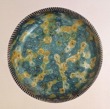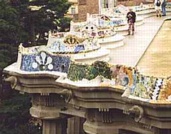
This technique was used by the Romans in regularly shaped pieces of marble in its natural colors to decorate their villas. It was later adopted by Byzantine artists using pieces of glass with irregular surfaces to tell the Christian story on the walls of their churches.
Mosaics are among the ten classes of patterns.
(pr. mo-zay'ic)
Examples:

Greece, Shallow bowl, Late Hellenistic, 1st century
BCE,
fused mosaic glass, height
3.43 cm, diameter 13 cm,
George Ortiz collection. See Greek
art.

Roman, Antioch, Asia Minor, The Drinking Contest of Dionysos and Heracles,
c. 100 CE,
mosaic, Worcester Art Museum, MA. See Roman art.

Late Roman, from a villa at Daphne, near
Antioch, Asia Minor, Hunting Scene, early 6th century CE,
mosaic, Worcester Art Museum, MA.

Byzantium, Constantinople (now Istanbul), Hagia Sophia, South Gallery or Catechumena, The Deesis, third quarter of the 13th century, mosaic, Istanbul, Turkey. Christ's left hand holds a closed Book of Gospels as he raises his right hand in benediction. His face is strikingly realistic and expressive, as are those of the Virgin Mary and St. John the Baptist, who stand to either side of Christ. All are set against a golden background. The lower portion of the composition has been damaged. This and all other mosaics in Hagia Sophia were covered with plaster at the church's conversion into a mosque in the 15th century. This actually preserved the mosaics for later restoration, which began in 1929, when Mustafa Kemal Ataturk ordered the conversion of the mosque into a museum. See art conservation, Byzantine art, detail, deesis, and lacuna.

Iran, Mihrab
from the Madrasa Imami in Isfahan, 755 AH
/ c. 1354 CE,
mosaic of monochrome-glaze
tiles on composite body
set on plaster, 11 feet 3 inches
x 7 feet 6 inches (343.1 x 288.7 cm), Metropolitan Museum of
Art, NY. See Islamic
art and mihrab.

Aztec/Mixtec (Mexico), Double-Headed Serpent, 15th-16th century, mosaic of turquoise, iron pyrites and shell on carved wood, traces of gilding, British Museum, London. The snake was perhaps the single most important animal in Aztec religion. See ancipital.

Antoni Gaudí (Spanish, 1852-1926)
and Josep Maria Jujol (Spanish, 1879-1949), the serpentine bench
at Güell Park (Parc Güell), 1900-1914, trencadis
on cement, Barcelona,
Spain.

Telephoto shot of the top of the bench.
![]()


Details of the bench.
See serpentine and telephoto.
![]()
Also see feather, marquetry, mortar, parquetry, pique assiette (also called picassiette), plaque, and smalto.
https://inform.quest/_art